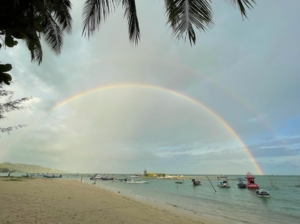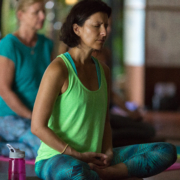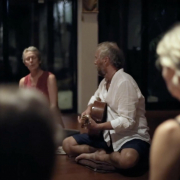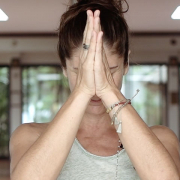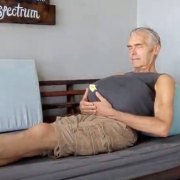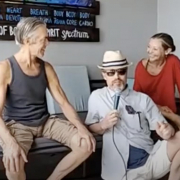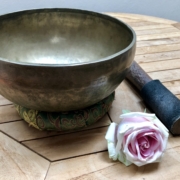 https://samahitaretreat.com/wp-content/uploads/2023/11/IMG_1290-2-scaled.jpg
1920
2560
Kirsten Mia
http://samahitaretreat.com/wp-content/uploads/2024/01/samahita-logo-v2.svg
Kirsten Mia2023-11-21 21:09:402023-11-21 21:09:40Music makes the world go round!
https://samahitaretreat.com/wp-content/uploads/2023/11/IMG_1290-2-scaled.jpg
1920
2560
Kirsten Mia
http://samahitaretreat.com/wp-content/uploads/2024/01/samahita-logo-v2.svg
Kirsten Mia2023-11-21 21:09:402023-11-21 21:09:40Music makes the world go round!Double Rainbows and Beachfront Wellbeing at Samahita
Something special seems to happen for human beings when close to the ocean. The magic of the seashore and beach visits have been an essential remedy to our modern, increasingly urbanized, way of living.Is it an evolutionary artifact, left over since we began this journey out of the water about 650 million years ago? Or is there some intrinsic value to both our evolved minds and bodies by being both on land and in the water that a beach offers?Do we relax by the water, at the beach, because it coincides with personal time? Or is it the power of Mother Nature in all Her Glory? In that sense She works on our systems in any truly natural setting, on a mountain or in a forest. Yet the land-meets-water component of Mother seems to be particularly healing, especially rejuvenating.Though I have had the good fortune to set up a special place like Samahita in pure nature, on the beach, life limits me to be away from it for many months in the year. All I know is each time I arrive back at Samahita’s beach I need to immerse in the sea water. Quickly, tiredness from a half-way-round-the-world travel evaporates and any travel weary puffiness dissipates. The next morning I’m a new man.Naturally science has something to say about this, such as both the sound of sea waves and staring at the ocean impact your brain waves to a state of calm and peace, or the richness of contrasting colors and their emotional effect, as well as the impact of being and walking barefoot on the sand. The mere proximity to the ocean improves your state of mind, as a group of Japanese researchers concluded in their 2016 study.A separate Science journal study found how blue is associated with a boost of creativity. Not just breathing in, but even the smell of the sea, perhaps due to the level of negative ions in the air, do something special to soothe and calm you. In an esoteric sense there is something about the impact of the energy-meridian lines of this great body of water on our own systems. Overall, conclude the Japanese researchers, this coastal experience “positively affects individual wellbeing.”But as I was going through my notes and database of science papers I stumbled upon a paper I had saved a few years back on “The Secrets of Rainbows”, written by one of the American Meteorological Society’s members.And then I opened my photo file from the past few months and saw in front of me this double rainbow shot from Samahita’s beachfront (see header image).Though early philosophers from Aristotle (~350 BCE) to Avicenna (~1000 CE) speculated on the origin of rainbows, knowing them to be a feature of sunlight falling on raindrops, it was only in 1637 when Descartes offered a satisfactory explanation in his Discours de la Méthode. Ironically the same Descartes who has given us the mind-body dualistic separation today under Cartesian thought, where mind is distinctly different from the body. Opposite to the understanding of consciousness and energy (citta and prāna) in ancient Eastern thought systems.Regardless, from Aristotle to Patanjali to Descartes to the modern fashionably attired yogi-type person, we all love, admire, and go silent in front of Rainbows. For instance, do you know as the sun’s rays fall on a raindrop they emerge at an angle of less than 42º while projecting a cone of light back to the sun exactly at 42º?And do you know that billions of these raindrops distributed along a cone at the correct viewing angle contribute to the phenomenon of this “magic” we term so simply as a rainbow?And do you know when in the day the tallest, meaning highest arc, rainbow occurs? Just after sunrise. Due to the sun being only about 2º over the horizon.But what about the magic of a double rainbow? Well that’s simple (not really)!! It’s because the sun rays experience two internal reflections in spherical drops.All that science aside, here’s what is quite cool about the double rainbow, and something I only learnt while writing this. Take a closer look at Samahita’s double rainbow photo above. Notice anything? …….. {time passes} …… Look again at the colors of both rainbows. The order of the colors in the secondary rainbow is reversed from those of the primary rainbow, a sort of mirror reflecting rainbow pair.Apparently Hawaii is the rainbow capital of the world but we’re pretty happy with what we find on Samahita’s beach. Another Thailand specialty.And, yes, you guessed it, Samahita’s new beachfront rooms give you a morning (in fact all day) view of the sunrise, rainbows and more (not guaranteed:), and that healthy, rejuvenating Mother Nature gift of being on land at the water, right at the beach.Close your eyes, listen to the sea, smell the air, breathe in the extra electron of negative ions, so when you open your eyes you feast on colors of blue, pot of gold rainbows, and tropical palm trees. From your room!Come join us. And be happy.

Paul Dallaghan’s expertise with breathwork, body and meditative practices comes from three sources: over 25 years of daily dedicated practice and teaching these techniques; immersion in the original culture through one-on-one direct training in practice and study of ancient texts; doctoral scientific research at a leading US university (Emory) on yoga and breath in terms of stress, health and aging. Paul occupies a unique space to impart genuine teaching and science on these practices, acknowledged by his teacher and lineage (Kuvalayananda) in India as a Teacher-of-teachers and a Master of Breath, identified to carry the tradition (Pranayama). This places him as the only master-level yoga and breath practitioner currently immersed in scientific academic research on breathwork, stress and health. His sincere and ongoing role is to teach, write and research to help put out experienced and authentic information on these areas in a world full of confusion and conflicting messages both off and online.
For more on his background see his bio.
More from the Samahita Blog
